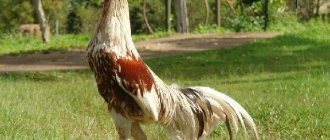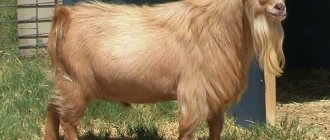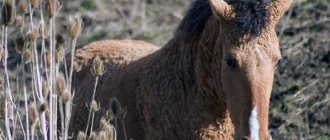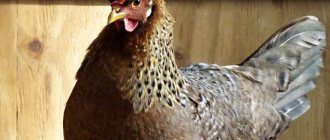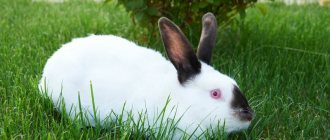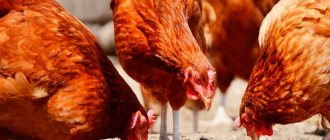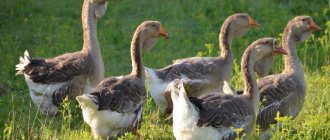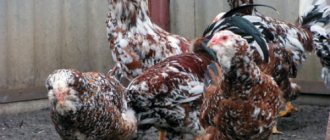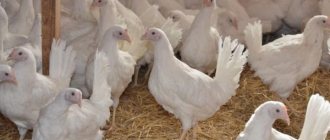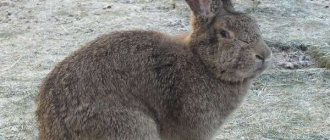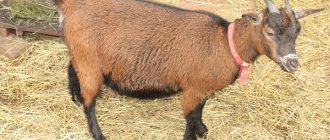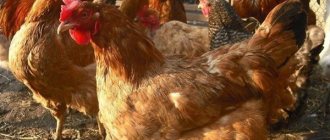Origin of the breed
This breed was standardized by the American Poultry Association in 1984. For the first time, residents of the northern continent of America saw a breed of chicken called Araucana in Montreal, the northern part of America, in 1967.
In the early 70s of the twentieth century, after many attempts, people managed to cross the American indigenous chicken with another breed - the Araucana. It was the discovery of the year. Chicken farmers immediately began to buy the birds because they were distinguished by high egg production and tasty low-fat meat. They were also kept as ornamental birds. Another difference between the breed is that the eggs are dark blue and olive in color.
What to do if chickens don't lay eggs well?
As mentioned at the beginning of the article, an Araucana chicken can lay up to 180 eggs per year
It is important to know the main reasons for the decrease in egg production. There are few of them, almost everything can be corrected on your own
Age. Araucanas begin laying eggs at six months and finish at the age of about 10 years. But with age, the number of eggs laid decreases. Breeders of this breed say that chickens most often lay eggs between the ages of one and two years. After this age, the stock should be replaced.
Overfeeding Overeating often leads to obesity, and, consequently, to a decrease in egg production. The weight of the laying hen should not exceed 1.8 kg.
Infection with parasites - helminths, lice eaters, feather mites and fleas. Infected birds become lethargic, restless, eat poorly and quickly lose weight. Chickens affected by feather mites begin to go bald
It is very important not to try to expel parasites using traditional methods, but to contact a veterinarian at the first sign of their appearance.
Birds of the Araucana breed
Appearance
In nature, there are 8 officially registered types of color: lavender, wheaten, olive, wheaten-blue, red-brown, blue, silver, dark yellow, white and black. There are also intermediate results that appeared by crossing such a large number of different plumage colors.
A distinctive feature of Ameraucana chickens is their beard and sideburns. These growths cover the entire head and are a tuft of feathers of a different color from the body, and their metatarsals are dark in color. The eyes are brown and large.
Medium-sized tails are set at an angle of 45 degrees and lie close to the body. Males have larger combs than females. Basically, they are similar, only the tail of Ameraucana roosters differs in the curvature of the feather.
Signs
Distinctive features of Ameriucana chickens are thick sideburns and a beard. They have not lost the ability to fly. The beak is curved and powerful. A comb with an elevation, at the point of elevation it has the shape of a bean. The tail plumage is arched and small. Their average weight can reach 3 kg, and for females - 2.5 kg. Sexual maturity is reached in six months, high egg production is observed in the first two years.
Depending on the color of the plumage, the skin of the limbs can be gray, white or blue. The earlobes are red. The color of eggs can be blue, green, olive, brown and even pink. If you look closely, you can see red or dark red eyes.
Chicken breeding
As a rule, crossbred breeds are not bred naturally because they lack the brooding instinct. Such females often show aggression towards chicks. Because of this, chicks and their mothers are kept separately. The young are hatched from February to March.
There are two breeding options: buy them from manufacturers or breed them using an incubator. It is believed that the second option is more profitable, but the first is more effective, because there will be more problems with the incubator. It is not recommended to buy chickens at the market. There is a possibility of stumbling upon frozen, hypothermic and out-of-breed chickens.
It is optimal to take chicks at the age of 14 days, when they have grown up. An insulated box with a woolen bottom will be needed for transporting chickens. An overly soft surface helps the chicks bunch together, but there is a risk that the chicks will injure each other.
Food for babies should contain the following elements: boiled water, an egg with herbs, protein-rich starter feed. After a month and a half, the diet is supplemented with other products.
Choosing eggs for incubation
Eggs for incubator must be carefully inspected before purchase. They must not have obvious defects. The form must be correct. Suitable eggs cost about 200 rubles on the market.
Points to consider when choosing eggs
When choosing eggs, you should pay attention to the following factors:
- Incubation materials (testicles) should be oval in shape. Cracks, deformations or dents of any kind are not allowed to incubate.
- If the material was stored in a room with a temperature below +8 C, then the death of the embryos has occurred, and it is not suitable for further development; such embryos are rejected.
- The material is stored for no more than 7 days, after which the embryos will also lose their capacity.
- If handled carefully, any material will hatch better.
Russian content
There are no special requirements for content. It is advisable to feed laying hens with foods that contain a high level of fat (corn, grains, seeds). They are not prone to obesity. Their plumage serves as a shield against the cold, but the main thing is to ensure that they do not pluck each other’s feathers. They need space, so it is recommended to provide them with a run.
Vegetables, whole grains, and wet mixtures are suitable for nutrition. Add premix or finely chopped fish. This should affect the color of the eggs. You can mix millet, sunflower cake, barley, ground wheat, corn. This will create a starter compound feed. The water must be purified and settled.
Maintenance in private households
For a comfortable life this breed needs:
- spacious poultry house;
- walking yard;
- constant access to clean water;
- quality food.
What should a chicken coop be like?
Sussex chickens are large in size, so a small, cramped house is not suitable for the breed. On average, the size of the room is selected in the ratio of 1 square meter of floor per 4-5 birds. The building must be equipped to meet the following requirements:
- the temperature in winter should not fall below 10 °C;
- availability of ventilation;
- cement floor with fine metal mesh;
- bedding made of natural materials 10-15 cm thick;
- availability of natural and additional artificial lighting;
- perches at a height of half a meter at the rate of 0.3 m per bird;
- arrangement of nests measuring 0.3 x 0.4 m in the shaded part of the room, each of which is designed for 3 hens.
Walking yard
The place for walking must be made 2 or 3 times larger than the chicken coop so that the birds do not have to be crowded. The enclosure must have a high fence; a fine mesh is sufficient. Chickens should be able to walk daily, so it is better to equip part of the site with a canopy. In winter, access to the outdoors is also necessary for Sussexes.
Drinkers and feeders
Containers for water and food should be located both inside the poultry house and on the run. It is advisable to purchase special drinkers and feeders for birds so that water and food do not fall on the floor. Like other chicken breeds, Sussexes are sloppy when feeding, so it is better to use bunker-type containers.
Planned herd replacement
The lifespan of Sussex chickens is 10 years. Gradually, egg-laying activity begins to decline, so the older population of chickens needs to be replaced. When raising a breed for meat, slaughter can begin after 70 days of the chickens’ life, when the weight reaches one and a half kilograms. Egg production of Sussex hens peaks at 1 year of age, so it is preferable to rotate the flock so that the majority of the birds are at peak production.
Description of the Russian Crested breed of chickens and maintenance featuresRead
Seasonal molt
For chickens of this breed, the seasonal change of feathers results in significant stress. Birds lay fewer eggs and also lose vitality. An oversight or change in living conditions during this period leads to a deterioration in the condition of the chickens. During molting, it is recommended to supplement the birds’ diet with a vitamin and mineral complex.
Chick care
Strong immunity, good appetite and a high degree of activity help the chicks to grow and develop rapidly. If you took a chicken from an incubator or brought one day old, then in the first 2 days of its existence the light should be on around the clock, on the third - 8 hours less, and from the 3rd week it should be turned down by another 7 hours. After 2-3 days, alternate 4 hours of light with 2 hours of darkness.
Take care of the warmth of the room in the first weeks (the temperature should not be lower than 31-36 degrees), gradually reducing the indicator to 13-20 degrees. There should be a drinking bowl in the room. It is necessary to monitor the cleanliness of the premises. For the first 2.5-3.5 weeks, feed 5 times a day, gradually reducing to 3 times.
Content Features
The best housing option would be a separate poultry house with its own, enclosed courtyard. The aviary should be spacious; you should not greatly restrict the moving bird. Drafts in the chicken coop are unacceptable, but a good ventilation system must be organized in the room. It is advisable to divide the space where you will keep Ameraucans into separate zones (for sleeping, feeding and walking).
Attention! Before moving a new flock into the chicken coop, it needs to be thoroughly cleaned: change the old bedding, disinfect the room and all equipment, whitewash the walls. You also need to make sure that rodents and wild birds do not have access to the poultry house.
There are no special requirements for the height, width and location of perches, but keep in mind that one adult bird needs about half a meter of free space (in the chicken coop and on the run)
Room humidity should not be higher than 60–70%
There are no special requirements for the height, width and location of perches, but keep in mind that one adult bird needs about half a meter of free space (in the chicken coop and on the run). The humidity in the room should not be higher than 60–70%.
The litter can be changed as it gets dirty, but it is better to do this as often as possible to avoid allowing large amounts of moisture to accumulate. You need to make several dust baths in the chicken coop. For this purpose, take wide (the size of the wingspan) wooden boxes and fill them with sand and wood ash 1:1. You can add a small amount of special powder insecticides to the mixture against various insects living in the feathers of chickens.
Adult diet
There should always be only clean water in the drinking bowls (filtered or settled), change it several times a day. You can feed Ameraucans without any extra frills; they take or prepare regular food, as for all meat and egg breeds of chickens. But the diet should be balanced; various wet mixtures, chopped vegetables, whole grains and grass (dry and fresh) are suitable.
Meat and bone meal, fish and blood meal, fish, dairy products, shell rock, chalk and ground eggshells are added to the food. Chickens that have reached puberty can be fed corn, grains and seeds, with a high level of fat content. Ameraucans are not prone to obesity.
Rules for keeping chickens
Chicks are born with dense down, but this does not mean that they can be kept in cool conditions. In the first week in a brooder or in a box with chickens, you need to maintain a stable temperature of at least 35 degrees, then it is gradually reduced to 14–19. Look at the behavior of the chickens; if they huddle together, it means they are cold, and if they try to avoid the heat source, they are hot.
The chicks develop quickly, gain weight, and are given a fairly spacious brooder. The litter (sawdust or peat) should always be dry, so as not to spend a lot of time replacing it, purchase special drinkers and feeders from which nothing spills or spills out.
Attention! The most viable broods are those hatched from the beginning of February to the end of March. For the first 3 days, lighting should be around the clock
Next, the light mode is adjusted so that the bird is with light for 4 hours and without light for 2 hours. After 3 weeks the light is left on for 10 hours
For the first 3 days, lighting should be around the clock. Next, the light mode is adjusted so that the bird is with light for 4 hours and without light for 2 hours. After 3 weeks, the light is left on for 10 hours.
The chicks are given only warm, boiled water. A special feed for chickens is suitable as a starter feed. It is better to strengthen the protein component, add chopped fresh fish, and when the chicks are a month old, you can chop the greens. For better growth of chickens, develop a feeding schedule and strictly adhere to it by the hour. For example, feed the bird 5 times a day for the first 15–20 days, then 3 times.
Observations of farmers have shown that the fundamental period in the life of Ameraucans is 2.5 months after hatching (the skeleton and muscle mass are formed). After this period, there is active weight gain; at week 15, the amount of food they consume will increase significantly. The better a chicken's muscles are developed, the sooner it will reach sexual maturity.
Feeding and diet of adult birds
The Ameraucana is a meat-egg breed and spends a lot of energy producing testicles. To replenish this energy, chickens need to eat well. If you provide them with a walk in the summer, they will find the elements the body needs on their own, but in the winter it is worth providing them with three meals a day.
The availability of water around the clock is especially important. Minerals are found in combined and green feeds. Compound feed should contain 15-21% animal protein, this could be, for example, fish waste, meat and bone meal, fish meal, dairy products.
In the summer they get juicy greens for themselves, but by winter they need to granulate and dry the greens to provide them with vitamins. Enrich your diet with fats. All dishes and drinking bowls must be washed and disinfected so that no dirt remains.
Advantages and disadvantages
Main advantages:
- good pleasant appearance of both the chickens themselves and the eggs;
- high protection from cold;
- unpretentiousness to the diet;
- have strong immunity;
- Eggs have high taste indicators;
- active (do not get fat);
- tend to mature quickly and begin laying eggs early;
- weight gain occurs in a short period of time.
Flaws:
- high sensitivity to dampness and drafts;
- up to 10 days the chickens are not strong;
- the likelihood of buying babies of an unclean breed is high;
- the instinct of motherhood is poorly developed, it is dangerous to keep a mother and a chicken together;
- the male is aggressive.
